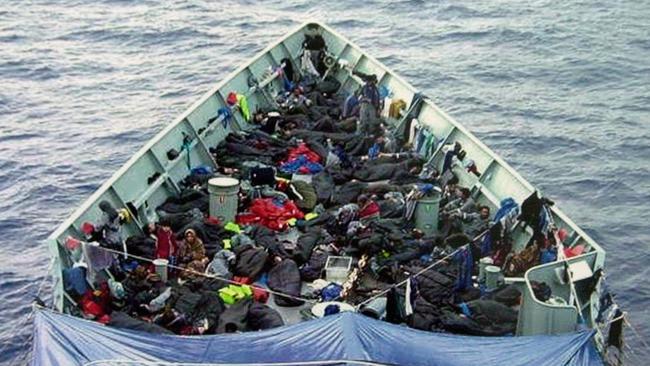
Forget South Africans, more Croatians please?
Home Affairs Minister Peter Dutton was spot on that South African farmers, terrorised by their own government and marauding compatriots, would likely make a strong economic contribution to Australia were they given refugee visas.
Of course, Australia can’t take all the world’s 23 million refugees, so why not prioritise those who are most likely to fit in economically? That saves taxpayers money in welfare, and minimises social discord.
It turns out skilled South African and English immigrants have unemployment rates of about 2 per cent, compared to a 5.6 per cent rate nationally, according to a 2014 study by the Immigration Department of arrivals between 2001 and 2011.
Dutton’s argument applies as validly to the whole immigration program — skilled, family reunion and refugee.
If we want immigrants with the greatest likelihood of integrating, look no further than southern and eastern Europe, it seems. Of the 31,000 immigrants from there since 2006, none is unemployed, according to estimates in the Australian Bureau of Statistics’ most recent analysis of the country’s migrant population. By contrast, of the 70,000 migrants from the Middle East and North Africa, 44,000 were either unemployed or not looking for work.
Of course, a bigger share of the latter had humanitarian visas. But Croatian refugees had an unemployment rate of 4 per cent, according to the 2014 department study, even lower than Chinese immigrants who hold skilled visas (6 per cent). The unemployment rates for Afghan, Iraqi and Sudanese refugees ranged between 19 and 22 per cent.
Without proper statistical analysis we don’t know to what extent language, education, culture, religion or particular circumstances explain the differences; but they are large. And the burden for taxpayers from those who don’t find work is the same.
From July our annual refugee quota jumps to 18,750 from 13,750 two years ago.
If the share of the additional intake that becomes dependent on welfare is the same as the share for our existing refugees — 59 per cent — taxpayers will be up for another $70m a year, before factoring in any health, housing and education benefits. And that excludes the cost of the special intake of 12,000 Syrians and Iraqis last year.
By contrast, only 2 per cent of immigrants holding skilled visas were dependent on government for their income (alongside 12 per cent or 25,000 of those with family reunion visas, which make up about 30 per cent of the 190,000 permanent visas offered each year).
“The single most important measure of successful settlement in Australia is the ability to communicate in English,” states that 2014 analysis, written by David Smith and Therese Smith.
So, notwithstanding worker-bee Croatians, why not prioritise refugees, such as South African farmers, who can speak English?
The government funds more than 500 hours of free English-language training to migrants from non-English speaking backgrounds. But after 10 years in Australia, more than a third of refugees still can’t speak English. Even more than 15 per cent of those on “family reunion” visas can’t, according to the department study. Dutton was right to tighten up English-language criteria for new citizens last year; perhaps tighter standards for family reunion visas would make sense.
Indeed, a quarter, or 186,000 immigrants, from non-English speaking countries since 2006 haven’t had a job since they arrived, and three fifths of those hadn’t looked for one. For those from English-speaking countries the figures were 8 per cent, and a quarter. Overall, the unemployment rate for migrants from non-English speaking countries was 7.7 per cent in 2016 compared to and 2.1 per cent for those from the main English speaking countries.
Australians, along with Canadians, are the most welcoming people in the world. More than 60 per cent of English, French and Italians say they want to cut immigration in their own countries, yet here only 37 per cent believe our intake is too high, according to last year’s Scanlon Foundation’s survey of social attitudes.
But the share of voters who reject the statement “accepting migrants from many different countries makes Australia stronger” has increased from 26 per cent to 30 per cent since 2013 — the share that “strongly disagree” has increased from 7.8 per to 13.4 per cent since 2007. Today’s immigrants are more culturally foreign than they used to be.
The big Greek, German and Italian populations are dwindling, at the same time as the Indian and Chinese-born populations have grown to 469,000 and 526,000, respectively. Immigration from Muslim countries, in particular, has surged. In the past five years the Australian-born population has increased 6 per cent, while immigrants from Pakistan, Nigeria, Syria and Iraq, and Afghanistan have increased by 86, 75, 52 and 38 per cent, respectively, according to ABS data.
Whether we like it or not, Australians don’t have the same attitude to all immigrants. More than 60 per cent surveyed have a positive attitude to English-speaking migrants and Europeans, double the share well-disposed toward Muslims, according to the Scanlon survey.
A separate Life in Australia survey taken in 2016 found more than 41 per cent of voters had a “very negative” or “somewhat negative” attitude towards Muslim immigrants, with only 6 per cent offering the same view of Buddhists.
The government has dismissed calls to slash Australia’s migrant intake. Yet it will struggle to maintain public support for today’s levels if too many don’t like the make-up.
There’s evidence in Europe that greater levels of Muslim immigration have produced less than harmonious outcomes, and undermined support for immigration overall. Immigrants who are able to get jobs, support themselves, and integrate socially are more likely to be more widely supported.
Targeting our immigration and refugee quotas towards groups such as South African farmers, who, based on past experience, are more likely to integrate economically, might cause offence to some. But it would bring greater economic benefits, and underpin social cohesion, qualities any pragmatic nation should seek.




